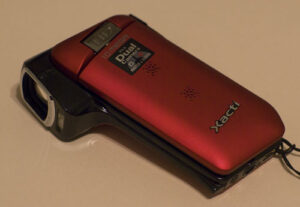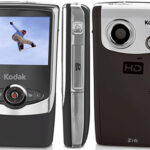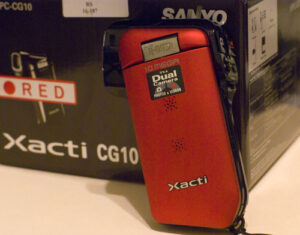

Finally this year I began seriously to consider taking the plunge with one of these small HD camcorders. There were two motivations. First, I realized that I barely used my miniDV camcorder any more, bogged down by its relatively large size and the hassle of having to capture tapes in real-time. Second, I tried to make some videos using my digital camera. While the camera’s specs say it shoots video in a resolution equivalent to full standard definition DV (640×480) I found the resulting footage to be really lacking in quality. On top of that, the video files were recorded in a relatively inefficient and obsolete format.
Although the simplicity of the Flip-style camcorders hold some appeal for me, I’m really not sure I can be satisfied with their lack of manual adjustments, zoom and other basic camcorder settings. I recognize how the average user probably doesn’t care and doesn’t miss them, and that the Flip brand camcorders have succeeded because they deliver good video with absolute operational simplicity. But I’m a bit more of a power user than that.

Unlike the Flip-style cams, the Xacti continues Sanyo’s pistol-grip design which I actually find to be more comfortable and easier to hold steady. 
I was further enticed by the camera’s manual exposure, sensitivity/ISO and even manual focus controls, along with the ability to shoot footage in black and white. A final enticement came from the fact that you can shoot still photos on the fly while you’re also shooting video. These stills are limited to 720p resolution (1280×720, or about 1 megapixel), but they’re more convenient than extracting stills from your video later. But the stills are a full ten megapixels when you’re not shooting video, which far surpasses most compact camcorders in any price range.
After playing with the cam for about fifteen minutes–thanks to unusually helpful Radio Shack staff–I bought the Xacti right on the spot. For the rest of this post I’ll be sharing my three weeks of experience with this camera, though it won’t be as thorough as a full review.
The first accessory I bought was an 8 GB SDHC card which allows me to record nearly 2 hours of full 720p video. Now, 2 hours in 8 GB means that a fair amount of compression is going. The same amount of HDV video in 720p or 1080i would require more like 26 GB of space. To achieve this kind of space saving the Xacti CG10 uses the dreaded AVCHD codec at a data rate of about 8 megabits per second (compare this to HDV’s 25 mbps).
Luckily, support for AVCHD has improved quite a bit in the three years since Sanyo introduced its first HD Xacti camcorder. I’m a Mac user and Quicktime plays the CG10’s video files with no problem. For editing I was able to import the files directly into iMovie ’08 and start editing immediately, which surprised me. The big caveat with iMovie (’08 at least) is that I cannot export my finished video at full 720p resolution; the limit appears to be 960×540. I’ve also edited the CG10’s footage in Final Cut Express, which requires that FCE convert the footage first, adding quite a bit of time to the editing process. I don’t know if this will change with Final Cut Studio 3 or a new version Express. For the moment I’ve been shooting mostly short vignettes, so iMovie has been adequate.
Since I produce educational video for a living it’s very easy for me to get bogged down in the technical details and obtaining high-end results. When I’m not at work I don’t want to be so encumbered and the Xacti CG10 has really freed me to enjoy shooting video for fun again. It’s bigger than pants-pocket-size, but easily fits in a bag or a jacket pocket, meaning having a true HD-quality camcorder with you is about as simple as having any other small digital camera.
Of course, all this convenience wouldn’t matter if the video quality didn’t measure up. I’m happy to report that the quality is quite good, especially at $200. As CamcorderInfo found, the CG10 has very good resolution, color and low noise when used in good light, and my experience confirms that. Since I’m accustomed to multi-thousand-dollar 3-chip professional camcorders, I don’t expect under-$1000 camcorders to perform well in low light, so I was not disappointed with the CG10’s video in low light. I wouldn’t say I was impressed, but I actually can get decent result, especially when I manually set the ISO sensitivity and exposure.
Yes, the newest pocket HD camcorder from Kodak boasts higher resolution, 1080p, at a lower price, but like digital cameras, more resolution doesn’t always mean better quality. I’m very happy with the footage the CG10 turns out, and think that, given this, 720p is not a compromise.
Still, while I’m quite impressed by the Xacti CG10, it’s not a perfect camcorder by any means. When it comes to picture quality it suffers from one of same major problems almost all of the inexpensive CMOS sensor based camcorders experience. I call the phenomenon “motion tear” and it should be familiar to anyone who has seen panning footage shot on a Flip or cellphone camera. I can only describe the footage as getting “swimmy” when there’s camera motion. This is because the CMOS sensor (as opposed to a CCD sensor which is predominant in most consumer and pro camcorders) records the image progressively from top to bottom, rather than all at once. So if the camera moves mid-frame, then the resulting image doesn’t quite line up. This phenomenon isn’t just a problem with Flip-style cams, even the much more expensive, but popular, Canon 5D MKII SLR’s video.
The solution to “motion tear” is simple — don’t move the camera. Of course, that’s advice for shooting video in general. Most new amateur videographers move the cam way too much. Nevertheless, there are times when you want to pan or tilt, though it’s something you want to limit with the Xacti. The problem here is the cam is so small and light it takes effort just to keep it still in your hands. I have learned to keep it pretty darn still by using two hands to hold both the flip-out screen and the camera body. But the better method is to use a tripod, monopod or even a small mini-tripod.
Another gripe I have is with the menu and manual controls. The menu is a bit arcane and difficult to navigate. And while I can set the joystick to have hotkeys to activate particular manual controls like aperture and focus, they can’t be adjusted on the fly while video is being recorded. You can only set them before taking video, which limits their usefulness for changing conditions, such as if following someone from outside to inside.
The lens cap is also stupid, being a cheap piece of plastic that snaps over it and is otherwise held on by a short tether. I’d gladly pay $10 more for an integrated cover like you see on most digital cameras these days.
The last aspect I’ll take up here is audio. In the past I’ve lamented the disappearance of microphone inputs from consumer camcorders. Much of the time your audio is more important than your video, and poor audio of speech can render an otherwise nicely shot video mostly useless. So I guess I’d better admit that the Xacti CG10 does not have a microphone input. The small stereo mics are actually located on the back of the LCD screen, which isn’t a bad location, since they will face most subjects head-on. But a nice feature of the flip-out screen is that it also flips around to face forward so you can easily record yourself. Problem being that your mics are then facing away from you.

As I’ve said, I’m having a lot of fun shooting video with the Xacti VPC-CG10. I do think you could do serious independent documentary or guerrilla filmmaking if you are willing to deal with the camera’s limitations. At $200 each a production could have multiple cameras on hand to do complex multi-angle stuff or to make sure you get lots of coverage. I also think the Xacti is ideally suited to video blogging.
I think the Xacti is best suited for videographers with a little experience who want a small camera but feel constrained by the limited features of a Flip-style camera. It works quite well in full-auto mode, so I don’t think experience is a requirement. Nevertheless I think the real value and utility of the CG10 is realized when you understand both its features and limitations.
So far I’ve mostly been shooting very short “slice of life” videos lasting less than a minute and it works brilliantly for that. Here’s one from the recent Chicago stop of the Tour De Fat:
I also really like the built-in black and white mode, which gives the footage a sort of super-16mm film look that I find appealing:
Finally, I do have to address the alleged “Dual Camera” feature of the CG10. Yes, it’s true that it shoots 10 megapixel stills, but I wouldn’t buy it to replace a regular still digital camera. The cam is optimized for video and so is always in video mode when you turn it on. There are separate still and video buttons, so at any time you can press the still shutter button and take a still picture. But it won’t happen quickly. It seems like the camera then switches to still camera mode, which takes a couple of seconds before it’s ready to take your picture. Good luck getting any kind of action shot. However, it does work and the resulting pics are decent, if not spectacular. It works in a pinch if the only camera you have is the Xacti. But if you primarily want to shoot stills, you’ll want a regular still camera.
Otherwise, for 720p HD video under $200, I recommend it.
Leave a Reply